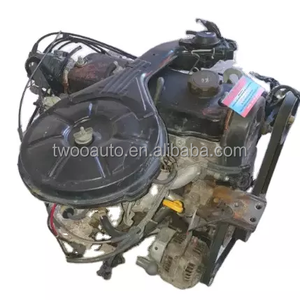Upgrade Your Cars and truck's Heart: Toyota Tazz Engine for Sale, High Quality Ensured
Upgrade Your Cars and truck's Heart: Toyota Tazz Engine for Sale, High Quality Ensured
Blog Article
Engine Purchasing Professional Tips on Picking the Right Engine for Your Details Demands
Choosing the right engine for your particular needs involves an intricate interaction of elements that go past mere horse power numbers. By diving into the intricacies of power versus performance, reviewing gas rankings, and budgeting for long-lasting expenses, one can truly maximize their engine choice.
Power Vs. Effectiveness: Locating the Equilibrium

When picking an engine, it is critical to strike an equilibrium in between power and efficiency to satisfy your particular needs properly. Power describes the engine's capability to produce energy for propulsion, identifying elements like acceleration, lugging ability, and general performance (Toyota Tazz Engine For Sale). On the other hand, efficiency connects to exactly how well the engine utilizes gas to produce power, impacting variables such as fuel economic situation and environmental friendliness
Attaining the best equilibrium between power and performance is necessary because an engine that is also powerful might consume extreme fuel, leading to higher operating expenses and unnecessary stress on the setting. On the other hand, an engine that focuses on effectiveness over power might result in slow-moving performance, particularly in requiring scenarios like towing heavy tons or driving uphill.
To make an informed decision, take into consideration aspects such as your regular driving problems, the desired use of the lorry, and your personal preferences. By reviewing your requirements and priorities, you can choose an engine that strikes the best equilibrium between power and efficiency, guaranteeing optimal performance while reducing ecological influence and operating expense.
Understanding Engine Size and Kind

Usual engine kinds consist of inline engines, V engines, and rotary engines, each with its distinct advantages and drawbacks. Understanding the interplay in between engine dimension and kind is important in choosing an engine that aligns with your specific demands and top priorities, whether it be power, performance, or an equilibrium of both.
Consider Your Lorry's Demands
Considering your automobile's needs is an essential action in the engine option procedure to make sure ideal efficiency and performance. It is necessary to assess factors such as the planned use the vehicle, its weight, lugging capacity, and fuel effectiveness requirements. For example, if you are seeking an engine for a durable truck that will certainly be used for towing, you will require a powerful engine with high torque abilities. On the other hand, if you are choosing an engine for a portable automobile largely used for city commuting, gas efficiency may be a much more critical element to take into consideration.

Evaluating Gas Efficiency Ratings
Assessing gas effectiveness scores is an essential element of picking the ideal engine for your automobile, making sure expense savings and environmental sustainability. Gas performance scores, normally click this site determined in miles per gallon (MPG) for gas engines or kilowatt-hours per 100 miles (kWh/100 miles) for electric engines, show exactly how far a vehicle can take a trip on a certain amount of fuel or electricity. Greater MPG or reduced kWh/100 miles values symbolize a lot more efficient engines, converting to minimized fuel prices and reduced carbon emissions.
Additionally, contrast different engine choices within the very same automobile class to determine the most cost-effective choice. Aspects such as engine size, weight, the rules of aerodynamics, and hybrid or electrical capabilities can all affect fuel efficiency.
Budgeting for Long-Term Prices
Purposefully preparing for lasting expenses is crucial when selecting an engine, making certain monetary sustainability over the lorry's life-span. While the preliminary acquisition cost of an engine is a substantial factor, it is important to consider the lasting prices connected with upkeep, repair work, and gas intake. Choosing a more fuel-efficient engine might have a greater in advance price but can cause substantial cost savings gradually. Normal maintenance, such as oil changes, filter substitutes, and tune-ups, is vital to keep the engine running efficiently and successfully, lowering the threat of costly repair work down the line.
In addition, investigating the availability and this hyperlink price of substitute parts for the selected engine is essential in budget planning. By thoroughly budgeting for these long-term expenses and factoring them right into the decision-making process, individuals can select an engine that not only meets their prompt needs but also stays cost-effective throughout its lifespan.
Conclusion
To conclude, picking the right engine for your certain requirements requires stabilizing power and efficiency, recognizing engine dimension and kind, considering your automobile's demands, evaluating gas performance scores, and budgeting for lasting expenses. By thoroughly considering these factors, you can guarantee that you select an engine that satisfies your demands and gives optimal efficiency for your lorry.
To further improve the selection procedure of an engine that strikes the ideal balance between power and efficiency, it is crucial to dive into the intricacies of understanding engine size and type. Engine size refers to the complete quantity of air and fuel that can be pushed via the engine cylinders. Usual engine types include inline engines, V engines, and rotating engines, each with its distinct benefits and disadvantages. Understanding the interplay in between engine dimension and kind is essential in choosing an engine that straightens with your details requirements and top priorities, whether it be power, performance, or an equilibrium of both.
Fuel performance scores, generally determined in miles per gallon (MPG) for gas engines or kilowatt-hours per 100 miles (kWh/100 miles) for electrical engines, suggest how far a vehicle can travel on a particular amount of gas or electrical power.
Report this page